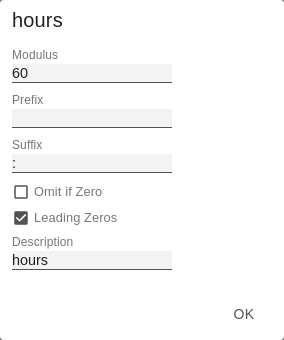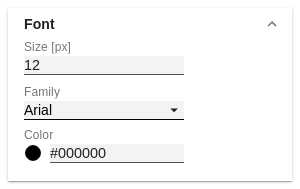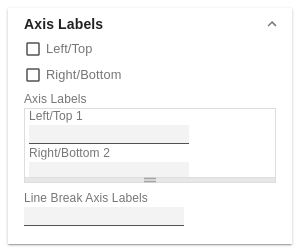en GPS Tab3 Labels (charts) LDE
Value FormatWith the Value Format you define the way values are displayed in the diagram. Use Pre-Formatted DataIf this option is activated, the number formatting of the data source is used. Value Format basicSelect the format of the absolute and percentage values according to guidelines of numeral.js. locale sets the label country format in the Basic mode. DE, FR, EN and AUTO are available options. Choosing AUTO the Locale is retrieved from the Data Source. Value Format extendedIf a fixed format is preferred, put the format for absolute and percentage values here. Choosing a “(“ in the box Negative Sign will show negative values in brackets: (1234). The parameter in the box Scaling is used as a divisor for scaling the data label. The resulting format string can also be set via scripting language – for further details see the Number Formatting. NULL Value ReplacementIf set, all NULL values are displayed as this string. Infinity ReplacementIf set, all Infinity values are displayed as this string. Zero ReplacementIf set, all 0 values are displayed as this string. Suppress Zero LabelsHiding Category Labels in case of zero values. Value Format universalYou can access the configuration by clicking on an element in the list. Define the number format using the following options:
Time Units Pop UpFor the Format Type Time, a system of units can be configured with the help of the Time Units Property, which in the default setting consists of hours and minutes. Each number formatted in this way is then splitted in its values for each unit. The order of the unit list defines their relationship from the largest unit (top) to the smallest unit (bottom). Each unit contains the following options:
| |
Value LabelsLabel PositioningDetermine the mode that controls the data labeling. Three modes are available:
Collision Adjustment [px]Adjusts the collision algorithm of the labels of the auto mode of the value labels. The smaller the value, the more sensitive the algorithm is to collisions. Negative values are also allowed. (Note: Bold labels are not considered by the collision algorithm, so they always appear). BackgroundThis option draws a colored area behind the Value Labels. With Background Color you define the desired color. Background ColorWith Background Color you define the desired color of the area. Visible Element LabelsSpecify whether or not the element labelling should be displayed for a series. | |
Label PickingIf this option is enabled, you can use the subordinate settings to control which labels are displayed according to certain criteria. Consequently, only those labels that match the selected criteria are displayed. The following options are available: Force First Value LabelThe first label of a series is displayed. Force Last Value LabelThe last label of a series is displayed. Force Min Value LabelThe minimum value of each series is displayed. Force Max Value LabelThe maximum value of each series is displayed. Force Before SeparatorsAll values before a separator are displayed. This option depends on the settings under Separators. Force Peak LabelsThis option displays local minima and maxima. What a local minimum/maximum is can be controlled with the option Minimum Peak Size in %. Minimum Peak Size in %Determines how much values must deviate from their neighbors to be considered a local minimum/maximum. Check Only Leading Values For PeakThe peak calculation only refers to the previous value; the following value is not taken into account. | |
FontSize [px]This property determines the font size in pixel. FamilyDefine the global font. You can choose between Arial, Tahoma, Lucida Console, Verdana and Calibri or type in the name of a font which is installed on your system. ColorThis property determines the font color as HEX code. Alternatively, the Color Picker can be used. | |
TitleIf the Enable checkbox is activated, the title will be displayed. Title TextEnter a Title for the charts here. Multiline texts will be rendered accordingly, i.e. the line break will be applied. The following HTML tags can be used for formatting: 'b', 'i', 'p', 'span', 'div', 'br', 'h1', 'h2', 'h3', 'h4', 'h5', 'h6', 'hr', 'ol', 'ul', 'li' and 'blockquote'. For the following result this input is necessary: ACME Ltd. | |
Series LabelsLeft/TopActivate the checkboxes to display the data label on the left/top of the data series. Right/BottomActivate the checkboxes to display the data label on the right/bottom of the data series. Series LabelEnter the desired labeling of a series manually. Max Series Labels Width [px]Maximum width of the data series labels, up to where the padding is scaled. If this value is exceeded, the labels are cut off. | |
Category LabelsIf the check mark is set, category labels are displayed on the diagram. VisibilitySet line by line (level x) whether the category label should be displayed or not. Max Width [px]If this value is greater than 0, it indicates the reserved space for the category labels in pixels. If the length of the labels is greater than the specified width, they are shortened by omission points. For values smaller or equal to zero, the reserved space is calculated automatically. Max Category Label Width can only be set in Structure Mode and with deactivated hierarchical labels (Hierarchical Label Display set to false). Suppress RepetitionControls line by line (level x) whether repetitive category labels should be suppressed or displayed. Hierarchical Label DisplayEnables a hierarchical display of category labels. The category labels of each member are displayed in a separate column. The hierarchical display is only possible in Structure Mode. Line Break Category LabelsThe character or string in place of which category labels are split across multiple lines. For example, using a space for the label "ACT Jan 2001" would make it a three-line label. Category Label Rotation [degree]Specifies the angle by which the category labels are rotated. The rotation is counterclockwise. Crop Category LabelsIf this option is enabled, the category labels in Time mode will have a maximum width of the specified category width. If the labels are longer, they will be truncated by ... cut off. Selected Members in CategoriesSpecifies whether the members of selected measures should be displayed as a supplement in the category labels. Selected Measures in CategoriesSpecifies whether the selected measures should be displayed as a supplement in the category labels. | |
Axis LabelsLeft/TopActivate the check boxes to display the axis label on the left/top of the data series. Right/BottomActivate the check boxes to display the axis labeling on the right/bottom of the data series. Axis LabelsEnter the desired labeling of the axis manually. Line Break Axis LabelsThe character or string where the axis labels are split over several lines (similar to the property line break category labels). | |
TooltipsIf this check mark is set, tooltips are displayed on the diagram at runtime, showing detailed information for the corresponding element. Value Format basicSelect the format of the absolute and percentage values according to guidelines of numeral.js. locale sets the label country format in the Basic mode. DE, FR, EN and AUTO are available options. Choosing AUTO the Locale is retrieved from the Data Source. Value Format extendedIf a fixed format is preferred, put the format for absolute and percentage values here. Choosing a “(“ in the box Negative Sign will show negative values in brackets: (1234). The parameter in the box Scaling is used as a divisor for scaling the data label. The resulting format string can also be set via scripting language – for further details see the Number Formatting. Value Format universalYou can access the configuration by clicking on an element in the list. Define the number format using the following options:
|







